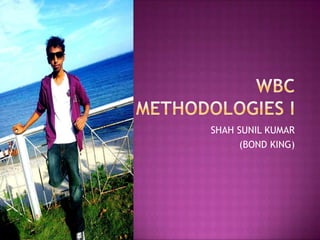
Wbc method
- 1. SHAH SUNIL KUMAR (BOND KING)
- 2. A. WBC count (Hemocytometry method/ Microscopic method/ Manual method) Counting chamber Pipets Diluting fluids 1. Counting chamber - improved neubauer
- 3. W W Area= 1mm square W W
- 4. 2. Diluting fluids 2-3% glacial acetic acid (gentian violet dye) 1% HCL Turk’s solution (methyl violet dye ) - Diluting fluid easy to prepare, must be isotonic, must be carciogenic (most toxic substance in 100 LL the benzene) - Hypotonic soln ( WBC) , Isotonic soln (RBC) - Only hemolyse mature RBC - Disadvantage of diluting fluid – nucleus in cytoplasm.(i.e. immature RBC will not hemolyse so counted WBC)
- 5. Short stem -WBC bulb is smaller than RBC -Upper calibration = 11 bead -Constant volume of pipet = 11-1 = bulb 10 -Volume of bulb is 10 times greater than volume of bulb Long stem
- 6. Procedure Suck the blood up to 0.5 mark. Suck diluting fluid to 11 mark. Shake the pipet for 2 minute. Discard first few drops. Charge the counting chamber – 3 minute for settling down. Count the WBC in 4 WBC square using LPO. Compute for total WBC count.
- 7. Computation WBC count = nos. of WBC counted x DCF x VCF DCF = vol. of bulb 10/0.5 =20 amount of blood sucked VCF = volume desired (1) 1/ 1x0.1x4 = 2.5 area x depth of counting chamber x nos. of square used. Normal value 5000 – 10,000 / cumm or 5-10 x 10^9/L.
- 8. B. Corrected WBC Count Done when there is high WBC count and there are more than 10 nucleated RBC per 100 WBC in the blood smear A = B x C A = corrected WBC count C+D B = uncorrected WBC count C = constant (100) D = nos. of nucleated RBC > 10 Nucleated or immature RBC will not hemolyse by hypotonic used in WBC as diluting fluids. In WBC count ,mistakenly immature RBC is counted thinking WBC.
- 9. C. Differential Leukocyte Count (DLC) Expression in % the relative number of the types of WBC. 4 general steps - blood smear preparation - staining - counting - reporting
- 10. 1. Blood smear preparation Wedge method – 2 glass slide method(most commonly used) Beacon’s method – coverslip and glass slide method Erlich’s method- 2 coverslip method
- 11. Procedure (wedge method) A drop of blood is applied near one end of the slide using capillary tube. The spreader is drawn back into the drop of blood and held until blood has spread across its width. The spreader at an angle of 40- 45 degree is pushed steadly along the slide to produce a thin, even film of blood.
- 12. Method of drying a smear Air dry Use of low flame Use of oven Immersion in methyl alcohol for 1-2 minutes. - Drying a smear (up – down) i.e. Reverse because in blood smear transaction of blood should be thinner to thicker.
- 13. Prerequisite for proper blood smear 1. Slide and spreader should be clean 2. Size of the drop of blood 3. Smearing should be done quickly. 4. Angle and pressure. Types of smear 1. Thick - parasite counting 2. Thin – cell counting
- 14. 2. Staining Romanowsky group of stain (basic stain – methylene blue , acidic stain – eosin, neutral stain – mixture of acid and basic stain – cytoplasm) * eosinophilic as granules found in cytoplasm Wright’s – most common Leishmann’s – urgent Giemsa’s – produce more delicate staining Jenner–giemsa May – Grunwald – giemsa (best method) * Wright stain and 50 drops buffer – Metallic greenish sheen.
- 15. Proper staining reaction Neutrophils – dark blue nucleus ; lilac pink granules. Eosinophils - dark blue nucleus; blue black granules . Lymphocyte - dark blue nucleus; sky blue cytoplasm. Monocyte – faint blue nucleus ; faint blue gray cytoplasm. * Robin- egg blue – sky - blue cytoplasm. - platelets – pale lilac blue - RBC – pinkish buff to orange. - bacteria – blue
- 16. Counting (scanning of smear) only used one method for entire Two field meander Four-field meander Strip method Exaggerated battlement Crenellation (most commonly used )
- 17. Reporting A. Relative count-gives the number of WBC type per 100 WBCs. nos. of specific WBC x 100 = % 100 N.R. Neutrophil - 51- 67% (bacteria) Lymphocytes – 25-33% (virus) Monocyte – 2-6% (bacteria) Eosinophil – 1-4% Basophil – 0-1%
- 18. B. Absolute count – gives the number of specific WBC type per cumm. Relative count x WBC count = / cumm (most informative method) N.R. Neutrophil – 1,600 -7,260 /cumm Lymphocyte – 960 - 4,400/cumm Monocyte – 180 - 800 /cumm Eosinophil – 45 - 440/cumm Basophil – 45 -110/cumm
